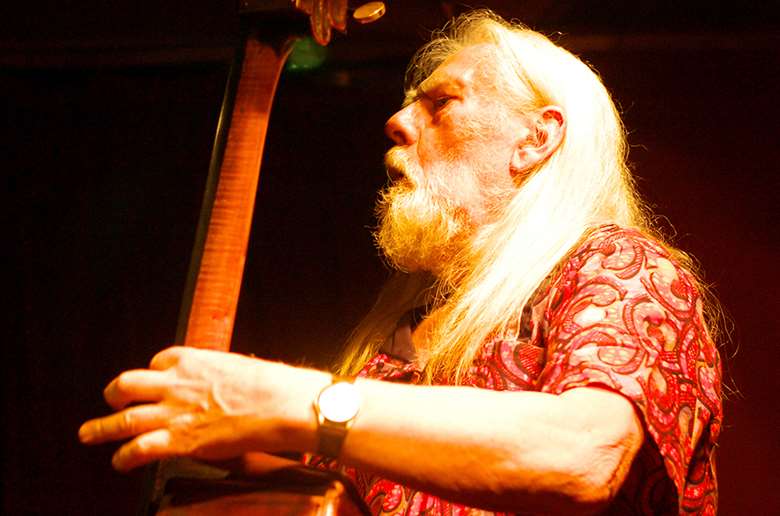Peter Ind – 20/07/1928-20/08/2021
Nick Hasted
Monday, August 23, 2021
Nick Hasted remembers the unique talents and extraordinary life of bassist Peter Ind who died on 20 August aged 93

“Did I leave?” Peter Ind wondered, asked by Jazzwise last year about yet another uprooting in a wandering odyssey of a life. “Or did I just keep moving?” Unreflectively, stubbornly, this giant among English bassists ploughed his own chosen course, ignoring obstacles and fashion’s vagaries. He was almost the last bop veteran standing, an oak you could sometimes believe would never fall.
Peter Ind had begun playing bass aged 14 in swing bands for jitterbugging servicemen, turning professional in 1947. By 1949 he was already leaving Blitz-scarred, narrow-minded Middlesex behind to join the likes of Ronnie Scott on the Queen Mary, playing for their passage and the reward of nights in Manhattan’s legendary 52nd Street clubs, just as bebop was born. Ind debuted in Birdland in 1950, depping with Lennie Tristano’s band, and Bird nodded his approval from the crowd when he played with Miles.
In 1951, Ind moved to New York, where he was taught by Tristano (pictured below playing together) and in turn taught classical, high-necked technique to Mingus, who treated him as a rare equal and friend. Moving into the 1950s downtown loft scene, he observed Gerry Mulligan develop cool jazz, and developed an enduring musical friendship with Lee Konitz. “It was just, as a player, I wanted to be good,” he told me in Jazzwise last year. “I wanted to be musically accepted. And eventually that happened.”

Ind mastered the walking bass style and bebop’s vertiginous demands as both were coined. He knew Rudy Van Gelder when he was an amateur New Jersey taper, and obsessively developed his own recording fidelity in a succession of home studios, taping the otherwise largely undocumented loft scene (tapes later released on his own Wave label). He was Konitz’s bassist for much of the 1950s, appearing on six LPs including The Real Lee Konitz (Atlantic, 1957). His own debut release with Tristano and Roy Haynes, the 7-inch single ‘JuJu’/‘Pastime’, included the first improvised overdub, with subsequent albums including Buddy Rich In Miami (Verve, 1958) and Jutta Hipp At the Hickory House (Blue Note, 1956). Ind’s own debut album, Looking Out, compiled recordings including Sheila Jordan’s first in 1961. Jordan, one of his very last jazz contemporaries, remained grateful for the chance.
By the early 1960s, Ind was engineering sessions for labels such as Verve, including Max Roach’s We Insist! The Freedom Now Suite (1960). He eventually looked back at those golden New York days in his excellent book about the milieu of his main mentor, Jazz Visions: Lennie Tristano And His Legacy (2005).
In 1963, he abandoned New York for an isolated house in the mountainous Californian region of Big Sur, a ruggedly difficult life for his first wife Barbara and their first child of two, though Konitz’s proximity helped. Here he committed to a parallel creative life as a painter, inspired by a 1953 Van Gogh exhibition in Philadelphia. He had ridden shirtless on a motorbike almost to the Arctic Circle then down to Italy in the summer of 1959, canvas strapped to his back and painting in the open air, the very vision of a British bohemian, free at last of inhibition. The deep, variegated blues of his “post-nuclear Impressionist” paintings crackle and spark, vivid with inner energy. This also reflected lifelong ecological concerns, expressed in his book The Environment and Cosmic Metabolism: Looking At The Stars And Thinking About The Earth (2008).
Ind reluctantly quit America in 1966, fetching up with his family in a stone cottage in rural Wales - another impractical home - then Twickenham. In 1967, he co-created the UK’s first full-time jazz course at Leeds College of Music, composing the syllabus and teaching. It was another milestone achievement which somehow inevitably ended with this unbiddable man being forced out.
Undaunted, he focused on Wave Records in 1981, building a studio by a Hoxton bombsite, and opening the Bass Clef club in its basement in 1984 (then the neighbouring Treble Clef in 1990). This was an unpretentious version of his 52nd Street haunts, dedicated to improvisatory fireworks, with the added dance-floor heat of steamy reggae and Latin nights. The clubs were yet another internationally recognised success, where Courtney Pine played and Sade and Leonard Bernstein propped up the bar. But the recession finished them in 1994, leaving Ind deeply in debt. He responded by collecting and painting ceramics. He also, always kept playing and painting, despite a stroke’s later depredations.
Ind and his devoted, invaluable wife Sue Jones spent much of their later time together in France and Spain, finally settling in the Sussex coastal village of Rottingdean, where his sprawling archive was catalogued, and an autobiography begun. When he played bass on a good day, I asked him, as we sat in its walled garden in the hot lockdown summer of 2020, how did he feel? “When I’m playing and it’s going well, it’s like – look at that,” he said. And he pointed to two butterflies dancing.